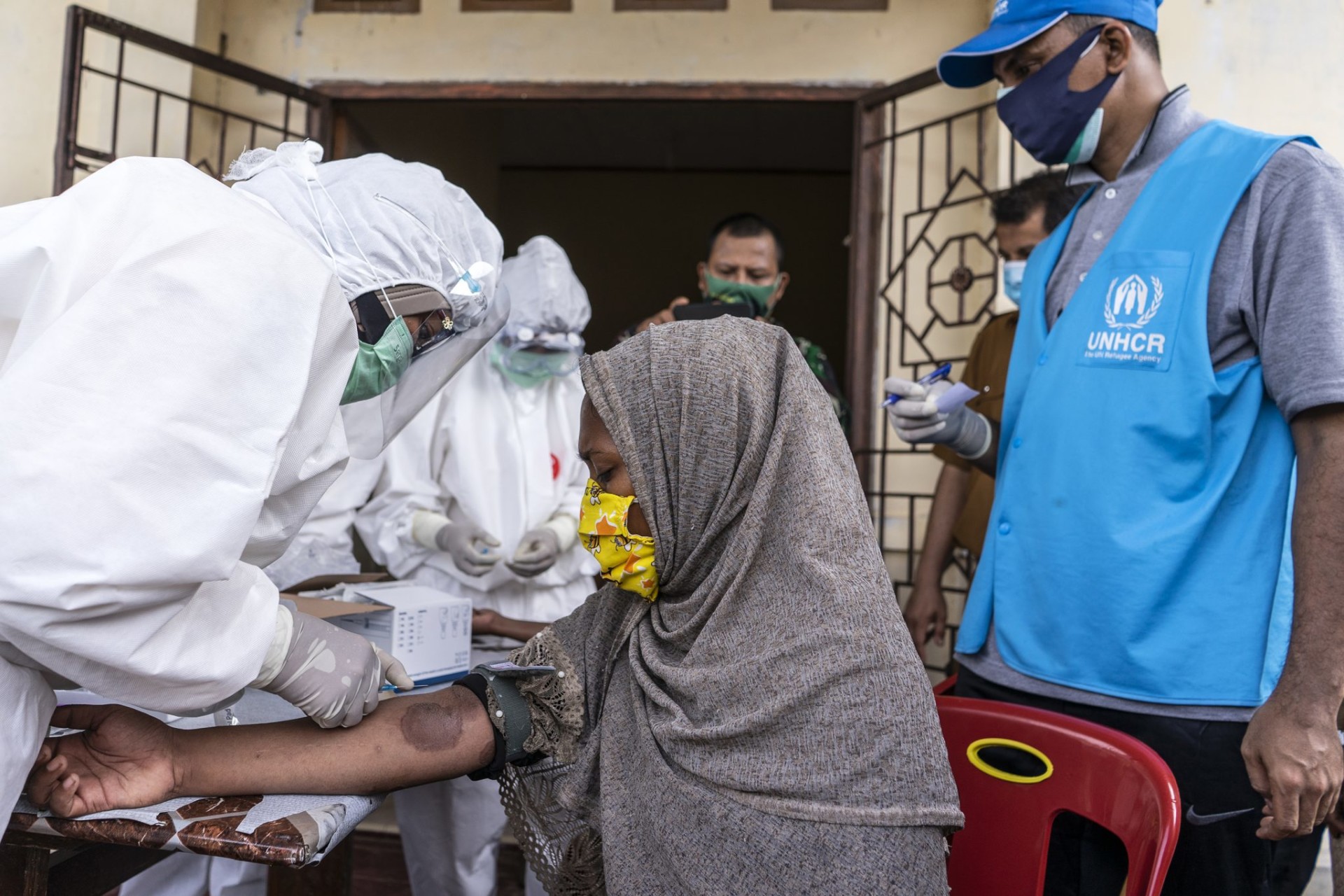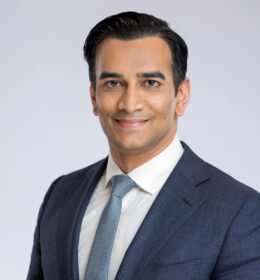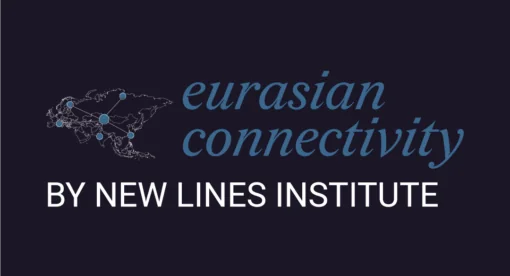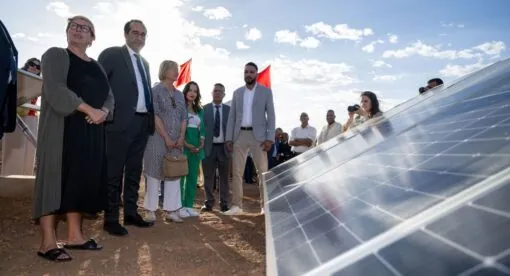In the midst of the global COVID-19 pandemic, refugees and internally displaced persons (IDPs) are among the most vulnerable to contracting the virus. Refugee and IDP camps and settlements are often overcrowded, lack adequate washing and sanitation facilities, and have limited access to health services. As COVID-19 reaches these camps, conditions are in place for the virus to spread quickly, and underlying health issues and vulnerabilities among refugees and IDPs make them susceptible to higher-than-average mortality rates. So far, there have been few confirmed cases in areas with refugees or IDPs, but a lack of widespread testing in some of these areas means health experts and humanitarians do not know the full scope of need.
This report looks at the contexts of some of the most vulnerable displaced populations in Bangladesh, Myanmar, Yemen, and Syria and projects potential case numbers and mortality rates of COVID-19 in these populations on the assumption of no significant health capacity being available to deal with the disease.
These populations could be hit next by COVID-19, and in order to save lives and prevent existing crises from escalating uncontrollably, a comprehensive response needs to be in place. Given that the World Health Organization is hampered by its insistence on working through the state authorities and the U.N. Commission on Human Rights (UNHCR) faces existing major financial constraints, there is an urgent need for the United States to take the lead on a response, ideally drawing in resources from the European Union and other wealthy countries, to avert a major disaster.
In 2019, the UNHCR had registered some 26 million refugees and a further 45.7 million IDPs, though both of these numbers are likely underestimates. Almost 90% of these refugees and IDPs live in 26 countries, and the only one with a health system with available capacity is Germany. The circumstances that refugees and IDPs face in each country vary based on a variety of factors, as some were displaced by a civil conflict but in an otherwise functioning society (such IDPs as Colombia) and others are held in what are effectively internal prisons by their government (such as those Rohingya still in Myanmar). Furthermore, this total does not include Palestinian refugees, who register with U.N. Relief and Works Agency instead. In Gaza, the situation is dire, with an entire population denied freedom of movement and lacking basic health services.
UNHCR camps are built to have 3.5 square meters of private space per person, which makes it difficult to to practice social distancing or to self-isolate. In informal camps and settlements, which are often makeshift and hastily put together, even this notional space allocation is not met. In this case, the only safety net is an already overwhelmed secondary health care system.
Data so far has shown that for people ages 20-29, around 1% of COVID-19 cases are severe enough to require specialist care, a number that grows to 15% for those over 60. Because of their lack of space refugee camps will likely see much higher case rates, and limited health care means that those who are seriously affected are less likely to receive the care they need to survive.
Methodology
This terrain assessment uses several sources. The World Health Organization (WHO) has produced a model that allows estimates of speed of spread of the infection. It is primarily designed to be used to estimate the equipment that will be required to handle an outbreak at a national level, so it has some weaknesses when applied to a portion of a state (such as the Rohingya still in Myanmar or the Syrian IDP population in Idlib) or in studying the impact on refugee communities within the wider population (such as the Rohingya in Bangladesh). The WHO model is based on a SIR (Susceptible, Infectious, Removed) population model to track the spread of the disease. Basically, the assumption is that over time, COVID-19 will produce a peak level of infection and then naturally drop off as few individuals remain susceptible to infection. Of course, if this peak overwhelms the available health care, the mortality rate will be very high. The models use two variants of the likely speed of spread: One assumes a 20% rate of infection spread, and the other assumes a 30% rate. Both of these are in excess of the infection spreads expected where a population group can use social distancing and isolation.

With the lower rate of spread, 17% of the population will have been infected by week 12 after the first significant infections. For the higher rate, this will reach 25.2%. For practical purposes, which of these two scenarios applies will depend on the extent to which people in affected areas can practice isolation and social distancing.
This data is used to estimate first the number of severe cases and then the likely death rates using the data from British medical journal The Lancet. In combination, this gives an overview of speed of infection spread (which is basically not age related) and mortality (which is highly age related).
The modelling is limited to the first 12 weeks of a major outbreak. In most cases at this stage the rate of infection will start to fall as many are already infected.
Yemen
Before the COVID-19 pandemic, Yemen was already facing a massive humanitarian disaster, with over 24 million people, or 80% of the population, in need of humanitarian assistance and 19.7 million people lacking access to basic health services. Poverty and malnutrition were widespread, as well as cholera, diphtheria, and measles. Of the wider population, over 2.5 million are registered as IDPs.
Five years of conflict have led to widespread destruction of health infrastructure, and the World Health Organization has documented 142 attacks on medical facilities across Yemen since 2015. Less than 50% of health facilities in Yemen are fully functional, and those that are functional largely lack enough equipment and medicine.
Yemen is facing dire conditions that can easily facilitate a rapid spread of communicable diseases, such as densely populated areas, water shortages, a devastated health system, and a lack of washing and sanitation facilities. Poverty and malnutrition are widespread. Earlier in 2020, the H1N1 virus was still present in the population. This lack of comprehensive health care, lowered immunity from malnutrition, and other underlying health conditions could put Yemenis at an even greater risk of contracting COVID-19, and an outbreak risks an unprecedented mortality rate.
On April 10, Yemen confirmed its first case of COVID-19 in Hadramout. Yemen has taken steps to reduce the risk of the virus spreading from abroad, including banning international flights, but internal measures such as self-isolation and social distancing are impractical for the vast majority of people. Authorities have managed to dedicate some of the remaining health capacity to COVID-19, but this is limited due to ongoing demands. There are only three available testing sites currently, in Sanaa, Aden and Al Mukalla.
Applying the transmission and age model to this population gives us the following estimates for the first 12 weeks of an outbreak:

Bangladesh
There are over 900,000 Rohingya refugees in the formal and informal camps around Cox’s Bazar, who already suffer from a lack of sanitation facilities and a shortage of soap, poor water quality, overcrowding in the camps, and lack of medical facilities. Over the past few years, the camps have faced outbreaks of measles and diphtheria.
By mid-April, there were 1,012 cases of COVID-19 in Bangladesh, likely a significant underestimate due to a lack of testing, and the first reported case in Cox’s Bazar was on March 31. By late July there were a few documented cases in the camps. If this spreads, the high population density, poor sanitation conditions, and inability to self-isolate will make a mass outbreak almost inevitable and will threaten to overwhelm the medical capacity.

Given the overcrowding, in this case, the speed of spread likely will be at the upper end of the estimated range. Some charities such as MedGlobal have implemented four-week COVID-19 response training for field staff and developed emergency triage procedures and clinical management protocols. However, by its nature such interventions are limited.
Myanmar
More than 300,000 Rohingya are still in overcrowded camps in Myanmar, denied basic health care, clean water, or sanitation. The Myanmar government first denied having any COVID-19 cases before eventually acknowledging that at least two people have been infected. Given the usually hostile attitude of the Myanmar government, there is a serious risk that any outbreak will be ignored until it is too late, as now seems to be the case.

The likely death rate among Rohingya within Myanmar compared to Cox’s Bazar is relatively higher due to the differences in population demographics. Again, overcrowding and other health problems would indicate that the faster rate of spread is the more likely estimate.
Syria
In the government-controlled regions of Syria, there is a vestigial health care system and some access to clean water and basic hygiene supplies. The real risk is in the northwest and northeast, which remain in conflict and have decimated health infrastructures. Across Syria, 11.1 million people are in need of humanitarian assistance. Some of this population are in the relatively well administered Kurdish controlled areas to the northwest, but many are in Idlib, where refugees fleeing the Syrian government have been deliberately displaced over the last few years. A recent escalation in the conflict has recently displaced over 950,000 people in the northwest, who are forced to live in overcrowded IDP camps and settlements.
This is the region of real risk due to ongoing conflict and decimated health infrastructure. The majority of IDPs lack the most basic needs, including shelter and access to health care. The health system in the area has been largely destroyed from the systematic targeting of medical facilities, with at least 595 direct attacks on medical facilities through February 2020, 90% of which were committed by the Syrian government and its allied forces. This has created a large-scale exodus of experienced medical personnel, adding an additional burden on those who remain. In northeast Syria, only one out of 16 hospitals is fully functioning, and there are only 28 ICU beds and 11 ventilators in the hospitals identified to treat COVID-19 cases. In the northwest Idlib governorate, there are only 1,937 hospital beds, with a 52% gap from the minimum number of beds that should be available for a normal health response, not even taking a COVID-19 outbreak into account.
In northern Syria, fears are growing about the impact of COVID-19 for millions of displaced women, men, and children in overcrowded camps. There have been no confirmed COVID-19 cases in northwest opposition-held areas or northeast Kurdish-led administration areas, but there have been recent reports of the virus being present. However, testing is not widely available in northern Syria. As the conditions in IDP camps and informal settlements lack even the most basic needs like sufficient shelter and are extremely overcrowded and unhygienic, social distancing and personal hygiene guidelines will be nearly impossible for people to follow.

The very unusual age profile of the IDP population in Syria points to further problems. If COVID-19 kills a significant number of the remaining adults, the younger children will be even more vulnerable to malnutrition and other infections.
Conclusion
The figures in this report suggest a mortality rate of 0.5-1% in the affected population groups, but this may be an underestimate. A key assumption is that those who have a severe attack of symptoms from the infection but did not need specialist care will recover. Given that each of the four population groups are already facing major health crises, this is overoptimistic; a 3-5% mortality rate may be more accurate.
In addition, the impact of COVID-19 on families and wider support systems should not be underestimated. Yemen is already on the verge of mass famine, and any disruption to the food and aid supply will have an effect far greater than direct mortality due to COVID-19. In Idlib, people are trying to live with no functioning social or civic infrastructure. In Myanmar, global relief agencies’ lack of access to IDPs is hindering their ability to build a true picture of the problem. Even those without a severe form of the illness will be unable to work, find food, or otherwise help their family group. In that case, the secondary impact may well be much worse than in other populations.
Recommendations
USAID and the State Department’s Office of Foreign Assistance should ensure that programs to assist vulnerable refugee populations meet the following criteria:
- Support local health and humanitarian organizations with personal protective equipment (PPE) and supplies like gloves and masks for medical staff and vulnerable populations. PPE is the number one need coming from field teams in these areas.
- Support comprehensive water, sanitation, and hygiene interventions. In refugee and IDP camps, supplies like soap, sanitizing solutions, and personal hygiene kits (including personal hygiene kits specifically for women and girls) are critical and often lacking.
- Build isolation and quarantine centers that follow public health guidelines and are unique to each context, setting, and cultural norms. All isolation facilities should be created in bottom-up consultations with local populations, to ensure that the facilities are usable in the individual content and that concerns of the most vulnerable are prioritized.
- Invest in psycho-social first aid and other mental health programs for refugees and IDPs. Self-isolation and social distancing has a significant impact on mental health, particularly among already vulnerable or isolated populations, and mental health interventions are important to hold concurrently with other health interventions.
- Improve relationships between refugees or IDPs and NGO workers. The lack of trust in medical volunteers and professionals is a serious barrier to care. This is particularly important in cases where they have been cut off from the internet.
Bangladesh:
- Humanitarian and health workers should be allowed to safely enter Bangladesh and the Cox’s Bazar camps without facing undue restrictions.
- The Bangladesh government should lift mobile and internet restrictions on the camps. Information and communication via the internet, such as telemedicine, is critical for slowing the transmission of COVID-19.
Myanmar:
- The Rohingya in the IDP camps in Myanmar are totally at the mercy of the Myanmar government. This limits access to health care as a matter of policy and refuses to even acknowledge they have any rights to live in the country of their birth. Consistent pressure needs to be placed on the government to acknowledge the basic rights of the Rohingya as well as to ensure the IDP population is able to cope with outbreaks of COVID-19.
Yemen:
- In March 2020, before the COVID-19 pandemic reached Yemen, USAID suspended funding for all aid in northern Yemen. There is now a funding gap for UN and NGO led programs, including health programs, in those areas. USAID should pause its aid suspension to ensure that humanitarian and health organizations have adequate resources to respond to COVID-19 and prevent its spread.
- Authorities and parties to the conflict should take immediate measures to ensure unimpeded access to humanitarian assistance.
Syria:
- Cross-border assistance into northern Syria should be scaled up. Additional tests and quality testing labs are necessary in northern Syria, as access to cross-border aid and laboratories in government-held areas is currently not available.
- U.N. Security Council Resolution 2504, reauthorizing cross-border aid into Syria, should be renewed for an additional 12 months with the addition of the Yarubiyeh border crossing. This resolution is particularly critical in light of the ongoing COVID-19 response.
- A major problem is the insistence of the WHO in working through the Syrian government, which in the past has diverted resources to regions it sees as loyal and ignored the needs of those it deems its opponents. At the very least, all COVID-19 related aid must be subject to strict tracking and accountability to ensure it reaches those in need in provinces such as Idlib.
Dr. Azeem Ibrahim is the Director of Special Initiatives at the Newlines Institute. He is also an Adjunct Research Professor at the Strategic Studies Institute, US Army War College. Dr. Ibrahim is also author of “The Rohingyas: Inside Myanmar’s Hidden Genocide” (Hurst & OUP) and “Radical Origins: Why We Are Losing The Battle Against Islamic Extremism” (Pegasus New York). He Tweets at @AzeemIbrahim.
The views expressed in this article are those of the author and not an official policy or position of the Newlines Institute.






